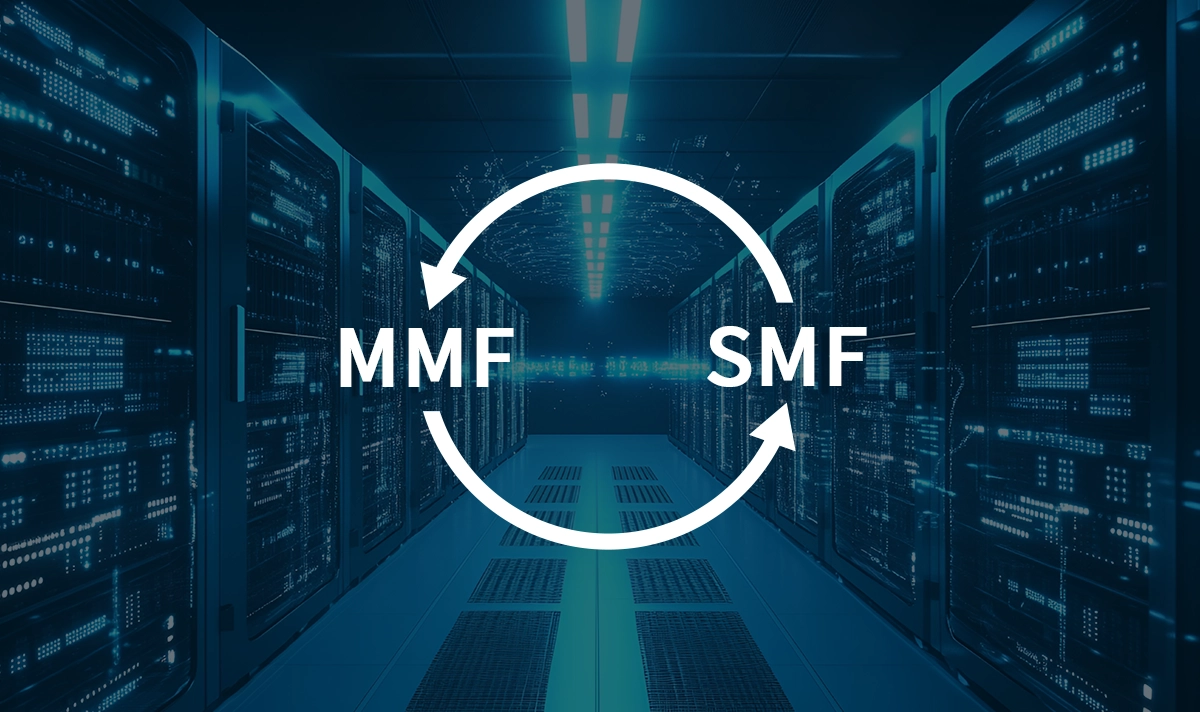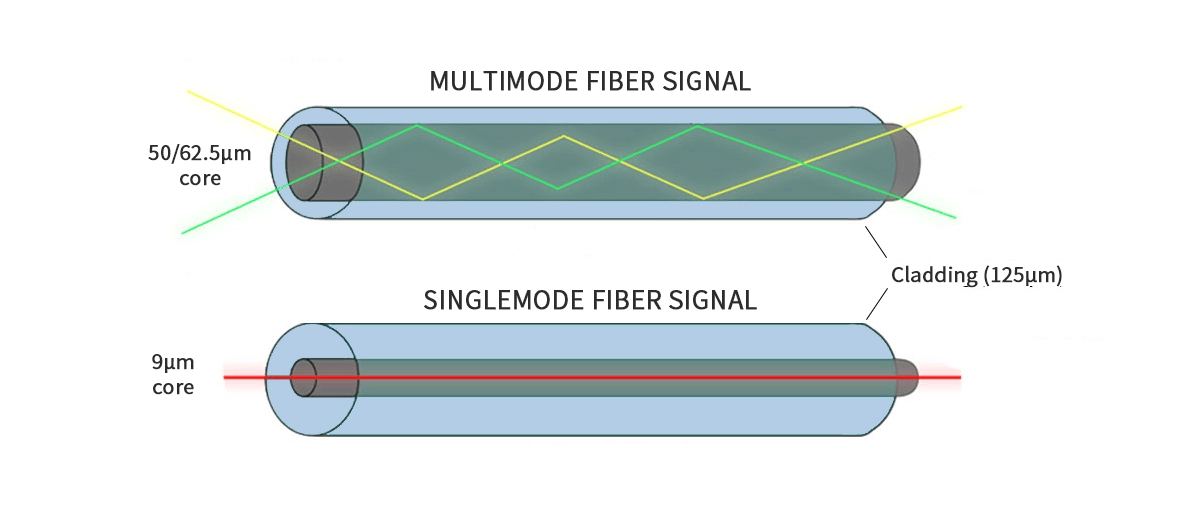
In the complex world of fiber optic networking, two giants dominate: Single-Mode Fiber (SMF) and Multi-Mode Fiber (MMF). Each has its ideal use cases—SMF for long-distance, high-bandwidth runs, and MMF for short-distance, cost-effective applications. But what happens when you need to connect an existing multi-mode campus network to a new single-mode service provider link? You can't just splice them together.
This is where fiber conversion comes in. This guide will break down the professional methods to achieve seamless single-mode to multi-mode conversion, ensuring your network integrity and performance.
📝 Why Can't You Directly Connect SMF and MMF?
At its heart, the incompatibility is physical. The core size of multi-mode fiber is significantly larger (typically 50µm or 62.5µm) than that of single-mode fiber (9µm). Connecting them directly causes severe insertion loss and modal dispersion, leading to a complete failure of the link.

📝 3 Professional Methods for Fiber Mode Conversion
There are several reliable ways to overcome this mismatch. The best choice depends on your budget, distance requirements, and desired data capacity.
1. Fiber Optic Media Converters 🖧
The most common and cost-effective solution, especially for Ethernet networks. Media converters are standalone devices that transform optical signals from one mode to another.
How it works: A media converter has two ports: one for SMF and one for MMF. It receives the optical signal on one port, converts it into an electrical signal, and then retransmits it as an optical signal on the other port using the appropriate laser (e.g., a 1310nm SMF laser to an 850nm MMF VCSEL).
Best for: Point-to-point links, extending network segments, and connecting building LANs (MMF) to WANs (SMF).
2. Mode Conditioning Patch Cables (MCP) 🔌
A simpler, more elegant solution for specific scenarios. A Mode Conditioning Patch cable is a special duplex patch cord that allows a longwave laser (e.g., 1310nm or 1550nm) to be launched into multi-mode fiber without causing distortion.
How it works: The cable has a single-mode fiber on one end that is precisely offset-spliced to a multi-mode fiber on the other end. This controlled launch condition prevents the differential mode delay (DMD) that cripples direct connections.
Best for: Primarily used when connecting GBIC or SFP transceivers that have a longwave LX/LH output to a multi-mode fiber backbone. Important: This only works if your transceiver is already specified for use with MCPs.
3. Advanced Optical Add-Drop Multiplexers (OADM) 📊
For high-capacity Dense Wavelength Division Multiplexing (DWDM) networks, a more advanced approach is needed. OADM modules can be designed to add, drop, or convert wavelengths and fiber modes within a central office or data center.
How it works: These are specialized, integrated systems that manage multiple wavelengths of light. They can be configured with internal conversion technology to accept a single-mode input and deliver a multi-mode output on a specific wavelength, and vice-versa.
Best for: Large-scale service provider networks, telecom companies, and enterprises using DWDM to maximize their fiber capacity.
📝 Choosing the Right Method: A Quick Comparison Table
Method | How it Works | Best Use Case | Relative Cost |
|---|---|---|---|
Media Converter | Optical-Electrical-Optical (O-E-O) conversion | Point-to-point Ethernet links, network extension | Low to Medium |
Mode Conditioning Cable | Controls laser launch into MMF | Connecting LX/LH SFPs to MMF fiber | Low |
OADM with Conversion | Advanced optical signal processing | Large-scale DWDM network interoperability | High |
📝 Key Considerations Before You Convert
Data Rate & Distance: Ensure the chosen method supports your required data rate (1G, 10G, 25G+) and covers the total link distance, including your existing fiber.
Wavelength Compatibility: Match the wavelengths (850nm, 1310nm, 1550nm) of your existing transceivers and the converter.
Protocol Support: Verify support for your network protocol (Ethernet, SONET, Fibre Channel).
Power & Management: Media converters require local power. Consider managed converters for remote monitoring and troubleshooting.
📝 Optimizing Your Network with the Right Optics
Often, the need for conversion arises from using older equipment. Upgrading to modern, compatible SFP transceivers can sometimes be a more efficient long-term strategy. For instance, ensuring all your edge devices use the correct multi-mode SFP modules can standardize your LAN and reduce conversion needs.
When high performance is non-negotiable, LINK-PP's 10G-SR SFP+ module delivers exceptional reliability for multi-mode deployments up to 300m, while our 10G-LR model is the ideal counterpart for single-mode long-reach applications.
📝 Conclusion: Connect with Confidence
Successfully converting between single-mode and multi-mode fiber is not just possible—it's a routine part of network expansion and integration. By understanding the methods available, from simple mode conditioning patch cords to versatile fiber media converters, you can design a robust, scalable, and high-performing network infrastructure.
Struggling with a specific network integration challenge? Our experts at LINK-PP are here to help you choose the perfect fiber conversion solution for your unique environment. [To Get Technical Support ➞]
📝 FAQ
1. How do you know when to convert multimode fiber to single mode?
You should convert when you need faster speeds or longer distances. If your network shows slow data or signal loss, switching to single mode fiber helps you fix these problems.
2. Can you mix multimode and single mode fiber in one network?
You can mix them using media converters, SFP transceivers, or mode conditioning patch cables. These tools help you connect different fiber types without replacing all your cables.
3. What is the easiest way to upgrade your fiber network for better speed?
You can use a media converter or mode conditioning patch cable. These methods let you upgrade quickly and avoid changing your whole network.
4. Does single mode fiber always give you better speed?
Single mode fiber gives you faster speeds and longer reach. You get the best results for large networks or long connections.
5. How much does it cost to convert fiber?
Costs depend on the method. Mode conditioning patch cables cost the least. Re-cabling costs the most. Media converters and SFP transceivers have medium prices.




